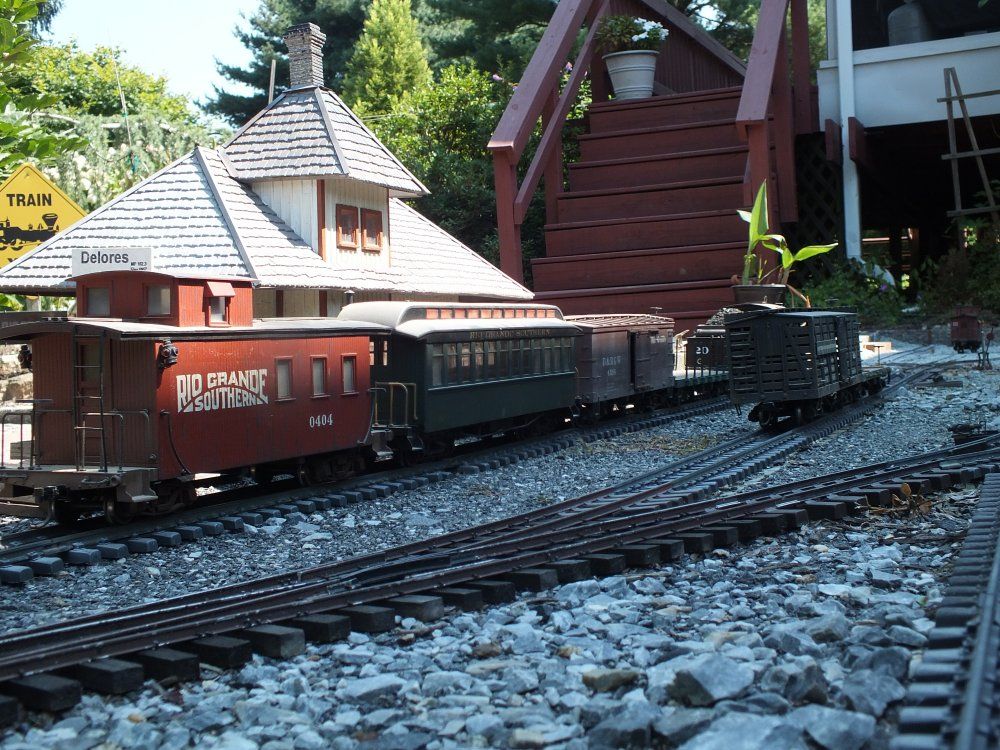Thanks to the generosity of Mr. Golding, a Bachmann EBT caboose showed up in the Tuscarora RR’s workshop. “A challenge!” says I. Let’s see what we can do with this thing. From a 1:20.3 scale perspective, the caboose is 25’ 8" long and 7’ wide. While a few inches narrower than the vast majority of narrow gauge cabooses, it’s still 7’, for which examples do exist. The caboose carbody itself (minus platforms) is 20’, which is quite respectable for a caboose. The height is low–6’ 5" from the bottom of the siding to the roofline–where 7’ give or take a few inches was more typical. Plausible, but not common.
The first thing I look at when “upscaling” a model is what I call the “human” element. Would a 5’ 10" person comfortably fit in the car?

My conductor is 5’ 10" (6’ with the cap). Here he is standing on the end platform of a stock Bachmann caboose. He’d have to duck his head a bit to get through the door, but he would fit. The height of the door is 5’ 6". The width, 1’ 8". With a figure standing on the back like this, you’d never really notice the door. The windows, however, are a bit low for what you’d typically find in cabooses. There are some cabooses that are more passenger-car-like with low windows, but they’re usually spaced as you’d find them on a passenger car, not just single windows as on this car. But if you’re looking for plausibility, it’s there. Narrow gauge railroads were odd ducks, so anything’s possible.
Having said that, look what happens when you raise the door to a more customary 6’:

The body of the caboose is raised only about 5/16". Our conductor no longer needs a steel plate in his hat to protect his head from low doors. More noticeable, though, is how it looks when in a train:

The roofline is brought up to the same height as what you see on passenger equipment and other cabooses. That’s a 1:20.3 EBT Caboose from Iron Horse Engraving in the background. Note the windows are now more in line with those on the 1:20.3 caboose as opposed to the lower windows on the passenger car.
So, what to do? I can’t simply leave the car at its original height. Next to the “proper” EBT caboose, it looks like a smaller-scale model, not its own unique car. That, and after seeing what happens when I add just a bit of height to the caboose, it’s got to be raised up.
Option 1: adding a letterboard to the top of the car:

Not objectionable, and the large lettering on the letterboard keeps the proportions of the windows somewhat balanced on the side, so they don’t look like they’re smack in the middle of the car. They’re still lower than what I’d expect to see on a caboose, but visually, they don’t look out of place. In terms of conversions, it’s a simple-enough process. For most folks, this is probably a very workable solution (if simply sticking larger trucks and a 5’ 10" conductor on the end platform isn’t enough). The problem is, when looking at this sitting next to my “proper” 1:20.3 EBT caboose, I still can’t divorce myself from the notion that this is merely an ill-proportioned attempt at an EBT caboose, and it will just look “wrong” no matter what I do to it. It’s the windows that do it.
Option 2: New sides:

As I am wont to do when searching for inspiration for non-EBT projects, I turn to other Pennsylvania narrow gauge railroads to see what they ran. My first “usual suspect”–the Tuscarora Valley RR–never had any cabooses. They ran only mixed trains. However, there’s another “TVRR” in Pennsylvania–the Tionesta Valley RR. They had a sizable fleet of cabooses. One in particular caught my attention - #111. For starters, this caboose only has 4 windows (technically 3) instead of 8, so right there, I lose the sense of “EBT-ness” brought on by the 8 windows on the Bachmann model. Additionally, the TVRR caboose has a freight door on one side in place of the window, which gives even more visual interest–especially on my railroad where trains run both directions thanks to the reverse loops. The TVRR prototype is 1’ 3" shorter than the Bachmann car, and only 6" wider, so the end result will be pretty close.
So, after years of borrowing surplus EBT cabooses, the Tuscarora RR will finally have a cabin car to call its own. When? Well, it’s on the “to-do” list of things that I want to get done before the convention this summer. It’s not at the top of that list, but I tend to work on projects as the mood strikes, so who knows? It’s certainly simple enough, so it shouldn’t take that long to put together.
Later,
K







